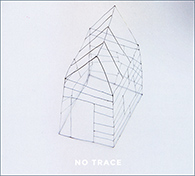Duo van Otterloo van Veenendaal
No Trace
(Brokken Records)
A fine
album, and one that at this time of the year could potentially solve a serious
dilemma: What to choose as a present for our friends - and ourselves! - now
that the Holiday Season is so near? (Sure, maybe I'm being too optimistic here,
but hey... Come the Holiday Season, I start believing in miracles!)
This is a
"Jazz" album, or at least, this is how it sounds to me. The
instrumentation? A fine duo of piano and saxophones, playing very well together,
with a shared goal. The album features ten compositions whose themes are quite
accessible and "singable", the development that follows offering a
transparent logic.
Albert
van Veenendal is a familiar name to readers of this webzine, with many albums
to his name in various situations, his prepared piano adding spices to a quite
rich and varied musical language (his solo album titled Minimal Damage,
released a few years ago, could work quite well as a starting point).
I'm not
as familiar with the work of Rutger van Otterloo, whose work on saxophone I
appreciated, a few years ago, on an album titled For A Dog, released under the
name Cram, the quartet fronted by fine guitarist Corrie van Binsbergen.
All
compositions on the album were penned by van Veenendaal. Total duration is what
I'd call perfect: that of a vinyl album.
Fine
recorded sound by van Veenendaal, edits and pre-production by van Otterloo,
mixing and mastering by Marc Broer. Fine sound: clear, dynamic, never
fatiguing.
With the
prepared piano adding timbral complexity, when it comes to saxophones I noticed
that, besides the more usual soprano and baritone, here we have the instrument
called "c-melody": a kind of tenor, but with a timbre that in the
upper range reminds me of an alto (pictures and notes are easily available on
the Web, for those who are interested, of course).
Though
the full quality of the work will only become apparent via listening, let's
have a look at those pieces all the same.
No Trace
starts with a piano arpeggio, slow tempo, then soprano, a melodic phrase played
unison, a fine theme. A piano arpeggio opens the "B" section, with a
fine development - and an overdubbing of soprano and tenor? - then a soprano
solo, the piano returns, then it's back to the theme.
Wrong
Exit starts with a "jerky" rhythmic cell, then the baritone, then a
piano ostinato, the baritone working in the upper range, then it's time for a
written melody. As elsewhere on the album, here the prepared piano is featured.
Then it's back to the ostinato, then a baritone solo, and a "cut"
ending.
Full
Spoon Moon starts with a slow piano arpeggio, then a theme played on
soprano, with a pinch of "in a sentimental mood", the piano playing
chords. Then the piece "fades".
Lighthouse
starts with a theme for tenor, the piano playing chords in parallel with the
melody. There's a brief "B" section, then the theme. There's a solo
section where the tenor plays arpeggiated variations in rubato, then it's back
to the solo piano, with echoes that reminded me of the Paul Bley-Marylin
Crispell lineage. There's a "hushed" tenor, then it's back to the
theme. The final section, which features the lower portion of the instruments,
and fine counterpoint, also offers a long moment which definitely reminded me
of The Art Ensemble Of Chicago, circa Fanfare For The Warriors.
Home For
Brunch gets its inspiration from the celebrated Eric Dolphy album Out To Lunch.
It features the soprano. There's an accelerando, then a unison of sax and
prepared piano. While paying homage to Dolphy, maybe because of the featured
instrumentation, this piece also highlights the link between Dolphy and Anthony
Braxton.
34 Steps
Into Reality opens with the strings of the prepared piano, high notes from the
soprano, and a "still" tempo, as an intro. The piano playing chords,
there's a melodic theme for soprano, arpeggios in the upper range of the
keyboard. There's a fine melodic development, a solo, then it's back to the
theme, then a coda for prepared piano.
Ventriloquism
starts with a very "dark"-sounding piano arpeggio, then the baritone
plays a theme with the piano. "Mumblings" from the baritone, the
piano acting as a counterpoint, then an octave jump. The ending goes back to
the "dark" theme.
On Patrol
starts with the piano playing a "bossa", the soprano here in the
upper range. There's a fine, light, airy, theme played unison by sax and piano,
then a melodic development, the two instruments chasing each other. Then a
soprano solo that takes us back to the bossa, and stop.
One Way
Ticket To Tibet starts with the baritone acting as a "pedal" below
the piano, then it's time for a unison of sax and piano, a "soft"
theme for sax, fine melodic development with sax backing. Then the theme,
played unison.
Sad &
Lonely starts with a "bluesy"-sounding motif for tenor, a
meditative-sounding piano as a background. There's a "hushed" B
section, then a light crescendo. While piano chords are sounding, the end takes
one by surprise, at a time when one is still waiting for more.
Beppe Colli
© Beppe Colli 2015
CloudsandClocks.net | Dec. 3, 2015











